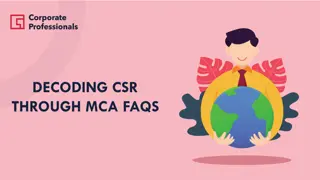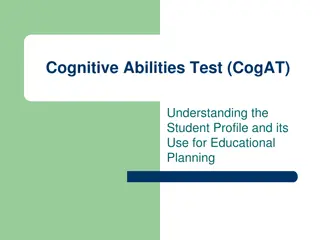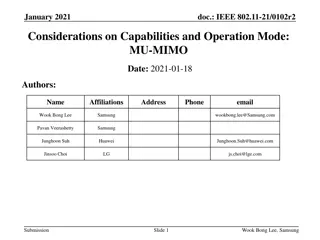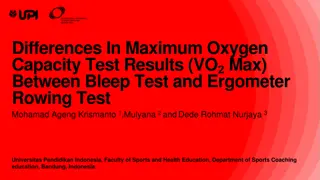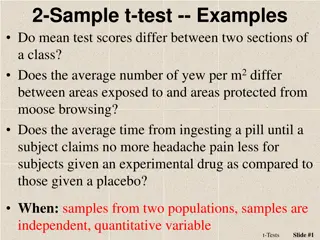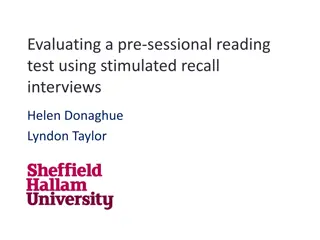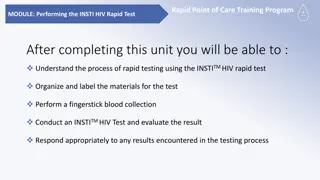Understanding MCA Test Results for Student Growth and Performance
Exploring the results of the Minnesota Comprehensive Assessments (MCA) for academic growth and performance. The images provided offer insights into understanding the overall picture, growth scores calculation, test level details, subject performance levels, and college readiness goals. The progression from individual student reports to comparative information at state, district, and school levels is outlined, emphasizing the importance of tracking student growth for college and career readiness.
Download Presentation

Please find below an Image/Link to download the presentation.
The content on the website is provided AS IS for your information and personal use only. It may not be sold, licensed, or shared on other websites without obtaining consent from the author. Download presentation by click this link. If you encounter any issues during the download, it is possible that the publisher has removed the file from their server.
E N D
Presentation Transcript
Understanding the Results Image placeholder Ye Tong, Ph.D. Pearson
San Antonio Open Plan Topics MCA Individual Student Reports 1 MTAS Individual Student Reports 2 Quiz! 3 2
Big Picture View Title Page Name, School, District Grade, Administration Year Overall Picture Performance Meter Standards State Percentile Rank Growth 4
Growth Score How are growth scores calculated? A student s growth is derived by comparing the MCA score for this year to his or her MCA score from the previous year. Expected growth is determined by comparing the student s MCA score this year to the scores achieved this year by Minnesota students who had the same score as the student the previous year. Scores in the vicinity of this year s expected score reflect Average Growth. Scores that are substantially lower or higher than expectations reflect Low Growth or High Growth, respectively. 5
Overall Test Level Details Scale Score Derived score based on students performance G40 and G50 are the cut scores Can be compared across students Can be compared across years for a given grade note the year revised standards are in place Linked to performance level requirements Comparative Information State Average District Average School Average 6
Within Subject Details Performance level within a subject Statistical methodology for determining performance levels Learning Locator Perspective resource site Lexile Lexile framework and resources 8
Growth Score and College and Career Readiness (CCR) What is the Goal Progress Score A student whose Progress Score is at or above the Goal Progress Score is considered on track to demonstrate career and college readiness at the end of grade 11. Grade 8 Goal Progress Scores are identified by linking the Grade 8 Progress Scores to those on a nationally recognized pre-college entrance exam that is predictive of performance on the nationally recognized college entrance exam used for the high school tests. The Goal Progress Scores of the lower grade MCA tests are established by MDE linking scores on those assessments to scores on the next higher grade s MCA. How are progress scores calculated? Off-grade items not contributing to on-grade level performance calculations, only to growth 10
CCR Report 11
College and Career Readiness (CCR) What is CCR goal score CCR Goal Scores are indicators that performance is on track to demonstrate career and college readiness on a college entrance exam at the end of grade 11. CCR Goal Scores are identified by directly linking scale scores on these tests to scores on the corresponding subject-level subtests from a nationally recognized college entrance exam 12
Science: Performance History Only Science Performance History Only No progress scores or CCR information Only selected grades Performance History Grades and school year Performance Level State percentile rank 13
MTAS ISRs 14
Big Picture Review Overall Picture Performance Level Standards 15
Overall Test Level Details Scale Score Derived score based on students performance Cut scores are 190 and 200 for all grades; Exceeds cut score varies by grade Can be compared across students Can be compared across years for a given grade Linked to performance level requirements Comparative Information State Average 16
Description of the Performance Standards Performance Standards Performance Level Detailed descriptions of what the student knows and can do 17
Rubric Details Scoring Rubric Information A total of 9 tasks Scores range from 0 to 3 Is the task answered correctly? Does the student respond to the task independently? 18
Detailed Report: Reading Reading Report Reading area descriptions Detailed point values for each reading area Reading access of the passages State averages 19
Detailed Report: Math Math Report Math area descriptions Detailed point values for each area State averages 20
Detailed Report: Science Science Report Science area descriptions Detailed point values for each area State averages 21
Additional Information Additional Information Where to look for additional information Quick Response Code 22
Quiz! 23
Question 1 My son was in 5thgrade two years ago and got a scale score of 560 on the MCA reading test; my daughter was in 5th grade this year and got a scale score of 580 on the MCA reading test. Can I compare their test results? Of course! Scale scores can be compared as long as they are based on the same sets of standards. Reading revised standards were implemented in 2013. Your son and daughter took the test that was aligned to the same academic and performance standards. Their scores can be safely compared. 24
Question 2 One of my students had low growth on his ISR. Does that mean he didn t progress at all this academic year? Low growth means his growth, compared with his peers from last year who scored similarly on the MCA, was substantially lower than expected. This does not mean he didn t have any academic growth; it does provide an indication, however, that he was not on par with his peers with his academic achievement this year. 25
Question 3 Johnny is a 6thgrader. On his report, he exceeded the performance standards; he also exceeded the goal progress score by quite a bit. Does this mean he is now college and career ready? No it does not mean that Johnny is college and career ready yet. Obviously Johnny is doing really well academically, as can be reflected from his MCA scores. However, exceeding the progress score only indicates that Johnny is well on track to demonstrate college and career readiness college entrance exam by the end of grade 11. It is not an indication that Johnny is demonstrating that readiness now at the end of 6thgrade. 26
Question 4 Kate is a 4thgrader and received a Lexile score of 940. I have heard that for X grade, the Lexile score should be X00. Does this mean Kate is reading at the 9thgrade level? No, it does not mean Kate is reading at the 9thgrade level. Lexile scores have ranges for a given grade. For 4thgraders, 25thto 75th percentile range is 445-810L; for 9thgraders, the range is 855- 1165L. The Lexile measure provides a good indicator to help locate the right level of materials for Kate to read. 27
Question 5 My student took the grade 7 MTAS test and was at the Exceeds Standards level. What does that mean? Can I compare the results to MCA Exceeds Standards level? MTAS and MCA are two different assessments targeting different student populations. We can not compare their results directly. The MTAS report includes the interpretations on what it means for a given performance level. That should be the guideline for interpretations on what the student knows and can do. 28
Question 6 Mya is Below Expectations on Algebra. What are the additional resources can I provide her to help improve her knowledge and skills in this area? There is additional learning locator information on the score report that is linked to the students performance. It matches instructional materials and sample items with the student s level in various content strands. You can log into the perspective site and access those materials that are matched to the student s level in the various content strands. 29
Additional questions? ye.tong@pearson.com 30




